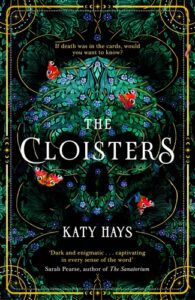By Katy Hays; reviewed by Jeannette Hartman
 Fate and self-determination dance together like shadows in this book.
Fate and self-determination dance together like shadows in this book.
The characters — struggling but ambitious graduate student Ann Stilwell; Met Cloisters curator Patrick Roland; his assistant, heiress Rachel Mondray; and Cloisters gardener Leo — play with and against each other like tarot cards in a spread.
Ann’s desire to become an academic researching early Renaissance art history seems laughable for a poor girl from Walla Walla who could only afford to attend local Whitman College.
The opportunity to join the Metropolitan Museum of Art’s Summer Associates Program as an intern seems to be her best chance to be accepted into a good graduate school.
By contrast Rachel is wealthy, Ivy League educated, beautiful, charismatic and socially savvy. In short, Rachel is someone whom people bend over backwards to help and promote. She’s rumored to be having an affair with her boss Patrick. Even Ann, a newcomer, can see the signs.
But Rachel seems to also have an intense relationship with Leo, a gardener at The Cloisters. Ann herself certainly feels drawn to him. A weekend musician and aspiring playwright, Leo brings more than muscle to his work in the gardens. They are designed to recreate medieval monastery gardens with herbs, aromatics — and poisons such as hemlock, belladonna, henbane and oleander. Many of the latter were used in small doses as medicines in ancient times.
Lastly, there is Patrick, a curator at The Cloisters with a passion for early Renaissance divination techniques and tarot. But his interest is more than academic: he believes the cards can actually be used to change the course of a person’s life. He holds candle-lit readings in the Cloisters’ library with Rachel. She is less of a believer in the cards. Patrick relies on Leo’s plant knowledge to mix mind-expanding herbal concoctions he believes will make him more receptive to what the cards have to say.
When Ann receives a box of belongings sent by her mother, she realizes they have been wrapped in waste paper that her father collected in his work as a janitor at Whitman College. Salvaging exercises and notes from professors’ trash cans allowed him to become a self-taught linguist.
But these papers came from the office of one of Ann’s art history teachers, Professor Lingraf, an expert in early Renaissance art. The pages appear to be transcriptions of ancient Italian documents, including a letter from an aristocratic mother giving her daughter a set of tarot cards that she believes not only foretell the future but can make it happen.
Ann and Rachel come to believe that a partial deck of tarot cards that Patrick has been trying to complete with the help of an antiquarian in the city, is the deck of cards referred to in the letter. They also believe that the letter helps pinpoint when tarot cards changed from being tools for a game to tools for divination.
With further research, this has the making of a ground-breaking journal article that could make the author(s’) careers. Rachel and Ann both know that if they share their findings with Patrick, he will take credit for the discoveries. Where will Fate take them?
In this story, ambition, greed, circumstance and personality create a bubbling cauldron of opportunities and exploitation. With its setting in a series of faux medieval cloisters and its shadowing of early Renaissance courts with their love of secrets, mysteries and power plays, this is an atmospheric tale for modern times.
The contradictions and secrets in the characters’ lives and the mystery of Patrick’s tarot cards make for a suspenseful story. The less than admirable characters who use fate as the excuse for their own evil deeds ultimately left me disappointed by this book.
The Author: Katy Hays
 In addition to being a writer, Katy Hays is an adjunct art history professor, living in California’s Olympic Valley where she teaches rural students from Truckee to Tecopa.
In addition to being a writer, Katy Hays is an adjunct art history professor, living in California’s Olympic Valley where she teaches rural students from Truckee to Tecopa.
In THE CLOISTERS, her first novel, she brought together a knowledge of art history, the workings of museums and galleries as well as research into the history of fortune-telling.
She has worked as a curator and researcher at major art institutions, including the San Francisco Museum of Modern Art and The Clark Art Institute
She holds a master’s degree in art history from Williams College and studied for a doctorate at the University of California at Berkeley.
#katyhays #thecloisters #jeannettehartman



Thanks for the great review!